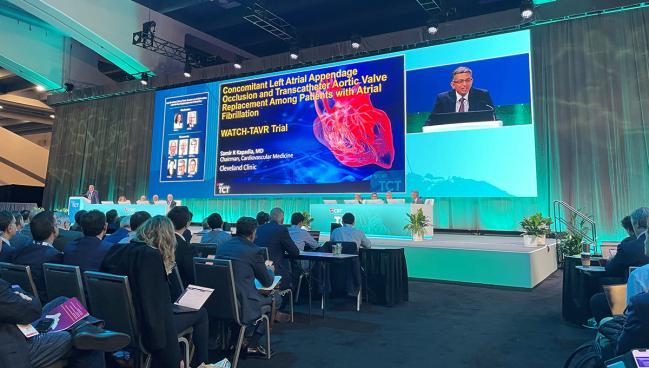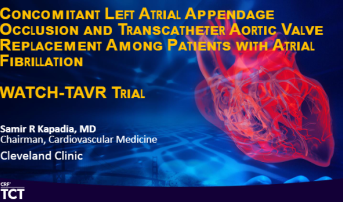WATCH-TAVR: Adding LAAO to TAVI No Worse Than TAVI Alone
(UPDATED) The field is likely moving toward greater use of combined transcatheter interventions, Megan Coylewright says.

SAN FRANCISCO, CA—Performing left atrial appendage occlusion (LAAO) at the same time as TAVI provides noninferior results compared with the valve procedure alone in patients with severe aortic stenosis and atrial fibrillation (AF), according to the results of the WATCH-TAVR trial.
Through 2 years, the rate of all-cause mortality, stroke, or major/life-threatening bleeding (primary endpoint) was 33.9% in patients treated with the combined procedure and 37.2% in those treated with TAVI alone, a difference that met criteria for noninferiority (P < 0.001) but not superiority, Samir Kapadia, MD (Cleveland Clinic, OH), reported here at TCT 2023.
There were no differences between groups for any of the individual components of that endpoint, or for most other secondary endpoints, although the rate of thromboembolism—mostly driven by venous events—was higher with the combined procedure (5.5 vs 1.1 events per 100 patient-years; HR 5.03; 95% CI 1.47-17.26). There was one in-hospital death in each arm.
The combined procedure “can be performed with low hospital mortality,” Kapadia said during a press conference, estimating that about 20% of patients treated with TAVI will later undergo LAAO. Doing both interventions at the same time “can be viewed as an alternative considering the complexity of the procedure and [the] few complications we listed.”
AF is common in the setting of aortic stenosis, and the presence of the arrhythmia is an important factor to consider in weighing the potential benefits of surgical versus transcatheter aortic valve replacement. That’s because when surgeons replace the valve, they will commonly exclude the LAA at the same time, an approach supported by LAAOS III trial. WATCH-TAVR explores that type of combined approach using only percutaneous techniques, with the idea that it would reduce the cost and inconvenience of bringing patients back for a second procedure.
Commenting on the results for TCTMD, Megan Coylewright, MD (Erlanger Health System, Chattanooga, TN), said, “It’s really important for interventional cardiology to think about doing multiple procedures at once for patients. When I talked to my patients about the concept behind this trial, they were really excited about the possibility of being able to have multiple disease conditions treated at one time, as is currently offered in surgery. So I think for that reason it’s important.”
Performing multiple procedures at one time would not only be more convenient for patients, who wouldn’t have to make additional trips to the hospital, but also would lower costs for payers and free up beds for health systems, she said.
Asked whether the trial provides sufficient evidence of safety and effectiveness to present the option for a combined TAVI and LAAO procedure to patients, Coylewright said, “Based on the results of the WATCH-TAVR trial, I feel we have the evidence needed to move the conversation forward to provide combined therapies to our patients with severe aortic stenosis and high risk for bleeding with atrial fibrillation in a way that will really benefit patients, families, clinicians, and hospital systems.”
The WATCH-TAVR Trial
WATCH-TAVR, conducted at 34 North American centers, helps fill that gap. The trial randomized 349 patients (mean age 81 years; 38.7% women) with severe aortic stenosis and AF to undergo TAVI and LAAO during a single procedure or TAVI alone. For LAAO, operators used the Watchman 2.5 device (Boston Scientific), treating patients with anticoagulation plus aspirin for 45 days after the procedure, followed by dual antiplatelet therapy (DAPT) through 6 months. In the TAVI-only arm, anticoagulation use was left to the discretion of the treating physician.
At baseline, the mean CHA2DS2-VASc score was 4.9 and the mean HAS-BLED score was 3.0. Most patients (85.4%) were taking oral anticoagulation and antiplatelet therapy (71.3%), with 59.3% on both and 2.6% on neither.
LAAO added a median of 38 minutes to the overall procedure time, and also required a greater median contrast volume (119 vs 70 mL) compared with TAVI alone. General anesthesia and transesophageal echocardiography (TEE) were more frequently used during combined procedures. Median length of stay was 2 days in both groups.
There were four moderate or large pericardial effusions during combined procedures—three of which required pericardiocentesis—and one during TAVI alone. The rate of acute kidney injury was no different between the combined and TAVI-only groups (2.8% vs 3.4%).
Through 2 years of follow-up, there were no substantial differences in clinical outcomes between the two groups, although major/life-threatening bleeding was numerically more common after the combined procedure during the first 6 months of follow-up and less frequent from 6 months to 2 years; these findings were not statistically significant.
In terms of medical therapy, patients treated with the combined procedure were more likely to be on antiplatelet therapy (82.5% vs 50.8%) and less likely to be on anticoagulation (13.9% vs 66.7%) at 2 years.
Eyeing the Impact of Recent Advances
Addressing the greater use of general anesthesia during combined procedures in WATCH-TAVR, the investigators note that in recent years, it has become more common for LAAO to be performed under conscious sedation. “Therefore, the procedural limitation for the greater use of general anesthesia may be minimized with recent advances in both procedures,” they say.
There was an apparent front-loaded of risk of bleeding in the combined group attributed to the required antithrombotic regimen with the Watchman 2.5 device, but Kapadia said that might be different with newer device generations. The “next-generation Watchman FLX device does not require this anticoagulation so hopefully we will mitigate the initial bleeding complications that we saw,” he said.
There are reasons patients would opt for a combined procedure rather than receiving the interventions sequentially, the investigators indicate. “From a patient convenience perspective, as well as the standpoints of safety of repeated interventions and cost, concomitant procedures could be of great value,” they write, noting, for instance, that a single CT scan could be used to plan both TAVI and LAAO. “This should obviate the need for additional investigations like TEE to assess the size and shape of LAA for procedural planning of LAAO and make preoperative evaluation of the combined procedure seamless and efficient.”
Initial costs are higher with the combined procedure, Kapadia et al acknowledge, but “LAAO delivers more quality-adjusted life-years and lower total costs within 10 years. WATCH-TAVR supports the reimbursement of concomitant procedures.”
Kapadia said he has talked with the Centers for Medicare & Medicaid Services (CMS) about reimbursement for the combined procedure, but there still isn’t such a code.
Indeed, the current lack of a reimbursement pathway for combining TAVI and LAAO is a barrier to adoption of this approach, Coylewright said. The trial “won’t impact my practice until we have a system that will support clinicians in providing these therapies at the same time, and right now there’s not reimbursement to do both procedures at once. So until we have buy-in from our payers, it won’t be something that will be possible.”
But combining procedures is likely to become more common in the future, Coylewright predicted. “I think that we will continue to evolve as a specialty where we will be able to offer patients more of the therapies for their cardiac needs in one setting.”
Kapadia agreed in a discussion following his presentation: “This is I think a new era where things are moving in the right direction.”
Todd Neale is the Associate News Editor for TCTMD and a Senior Medical Journalist. He got his start in journalism at …
Read Full BioSources
Kapadia SR, Krishnaswamy A, Whisenant B, et al. Concomitant left atrial appendage occlusion and transcatheter aortic valve replacement among patients with atrial fibrillation. Circulation. 2023;Epub ahead of print.
Disclosures
- WATCH-TAVR was funded by Boston Scientific.
- Kapadia reports holding a stock option from Navigate and having held stocks from Anteris within the last 12 months.
- Coylewright reports consultant fees/honoraria/speaking fees from Edwards Lifesciences, Boston Scientific, Medtronic, Occlutech, and Abbott.






Comments